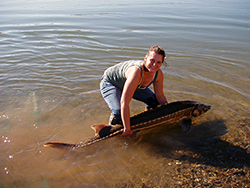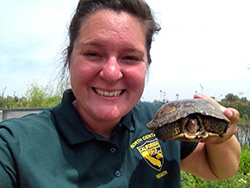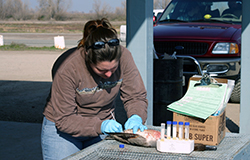
Laura Cockrell with an endangered Green sturgeon she tagged in the Sacramento River for a sturgeon movement study

Laura holds a Western pond turtle at Upper Butte Basin Wildlife Area.

Laura swabs a hunter-harvested Northern pintail for Avian Influenza sampling in 2007 at the Gray Lodge Wildlife Area.
Laura Cockrell is an environmental scientist at the Upper Butte Basin Wildlife Area, which is made up of three units covering nearly 9,700 acres in Butte and Glenn counties. Her duties include coordinating and conducting biological surveys on the wildlife area, managing wood duck nesting boxes, coordinating with volunteers and interacting with partners, including governmental agencies and non-government organizations. While most of her work involves surveying for game species, she has also captured giant garter snakes and western pond turtles for studies, and conducted surveys for yellow-billed cuckoos and Swainson’s hawks. Laura can also regularly be found planning habitat improvement and maintenance projects, writing reports, creating maps designed for public use on the wildlife area and generally assisting the public.
Laura graduated from California State University, Chico in 2007 with a Bachelor of Science in Biological Science with an emphasis in Wildlife Biology. She earned a Master of Science in Biology with a concentration on Applied Ecology from Eastern Kentucky University. Her thesis used Landsat imagery to evaluate trumpeter swan nesting sites in Yellowstone National Park.
Prior to working at the Upper Butte Basin Wildlife Area, she worked for the International Halibut Commission in Dutch Harbor, and for California Waterfowl in the Sacramento Valley, where she worked on summer mallard banding, pintail rocket netting, nest searches and wetland monitoring.
What led you into a career as a wildlife biologist?
I always enjoyed being outside and exploring as a kid. It took me a little while to find my path in college, but I chose to major in biology because studying ecology and nature sounded like a good chance to be outside every day. I signed up for a waterfowl course, and my passion for wildlife really took off after that.
Who or what brought you to CDFW? What inspires you to stay?
When I first started as a scientific aid with the department almost 11 years ago, I was working on the Avian Influenza Project. I swabbed hunter-harvested birds at the check station to be tested for avian influenza in the lab, and surveyed for bird die-offs throughout the region. I had never worked alone before, and it taught me a lot about how important it is to stay focused and on task when you are by yourself!
What inspires me to stay with the department is the potential I see for us to fulfill the goals of our management plan, and to improve habitat on the lands we have been entrusted to manage.
What is a typical day like for you at work?
It depends on the season. Waterfowl season is our busiest season as far as public use. It runs from late October through the beginning of February, but the preparation begins much earlier. During waterfowl season, I am usually in the office or at the check station. After waterfowl season ends, I finalize our hunt records for the end of season report and everyone is out monitoring the area flooding or inspecting damage from flooding. In the spring when we are in full survey mode, I will probably be out in the field before sunrise counting pheasant or quail. During the summer, I am usually in the field banding or in the office working on grant reports. Fall brings us back into preparation for the hunting seasons, where we have to prepare for September dove hunts, the J-9 zone deer hunt and waterfowl season.
What is your favorite species to interact with or study?
I have really enjoyed getting to work with western pond turtles and giant garter snakes. I took herpetology in college and it was great but “herps” were not really my thing until I got to work with them more. Any time we get to work with protected species and species of special concern is rewarding, and it is not something we get to do very often. Seeing protected species thrive on our wildlife areas means the hard work that goes into developing protections is helping local populations persist, and if the local population becomes healthy enough to expand maybe they can rebound throughout their range.
What is the most rewarding project that you have worked on for CDFW?
Upper Butte Basin Wildlife Area is one of the few wildlife areas with an agriculture lease, so we work with our farmers to support wildlife-friendly agriculture practices. Because of the winter flooding this year, some of the rice fields were too wet during planting season, and farmers will be enrolling those fields in the BirdReturns program, which is offered by The Nature Conservancy in partnership with the California Rice Commission. The Nature Conservancy and the California Rice Commission began this program in 2014 to compensate farmers who provide pop-up habitat for migratory shorebirds in the fall and spring by flooding fallow rice fields. We are planning shorebird surveys during fall migration and I am so excited to see how shorebirds will react, hopefully by returning to the area. During the shorebird survey, we will drive down the roads through the flooded rice fields and count the number and types of shorebirds that are using the fields. Normally, if the fields have been planted in rice, they would not be usable by the birds because they are looking for mudflats, not rice fields. We would hope to see a high diversity of species and large amounts of birds using the flooded rice fields.
What is it about the work you do that you would most like us to know?
There are many constraints on the work we do that are created by factors outside our control. A large part of the work on our wildlife area is managing wetlands, but the drought brought a lot of challenges with water management. We work with what we have, but sometimes it is not a lot and that can be frustrating.
If you had free reign and unlimited funding, what scientific project would you most like to do?
Wildlife overpasses/underpasses! Our wildlife area has a highway that bisects one of the units, and the amount of wildlife killed by vehicles is such a shame. A few years ago, we had four deer killed in a quarter-mile stretch in less than a week, and this winter someone ended up driving into a waterway at one of our units to avoid a collision with a deer! There are the standard “deer crossing” signs, but people often drive well over the speed limit and put themselves and wildlife at risk for a collision. There has been a great deal of success in reducing wildlife collisions where wildlife overpasses and underpasses were created. I would love build underpasses with elevated roadways for all the major roadways around our units.
What is the most challenging aspect of your career as an environmental scientist?
More than once, I have had to remind myself, “You signed up for this, so put a smile on your face and get it done!” Walking in waders to check traps when it is 110 degrees out is not fun. Examining a carcass that has been rotting for a week is not fun. Cleaning up garbage is not fun. However, all of those things are critical for what we do! So put a smile on your face, get it done and get on with it.
Is there a preconception about scientists you would like to dispel?
One of my classmates in college told me that I should switch to microbiology because “there is no future in studying plants or animals.” We need to understand our environment, how we interact with it and the impacts we make. Scientists are not always in a lab – they are out in the field, too. Obviously, I did not agree with his assessment or I would be a microbiologist! The guy that I was talking to felt like, career-wise, the money was in lab work and microbiology rather than fieldwork. Part of me can understand that line of reasoning, as there are more jobs with the medical profession if you target microbiology, but if that is not where your passion is then why would you take that path?
All photos courtesy of Laura Cockrell.